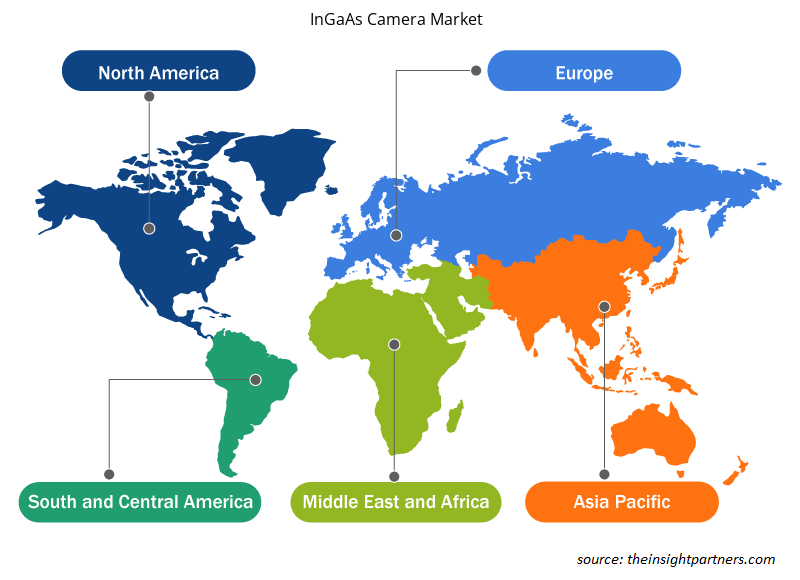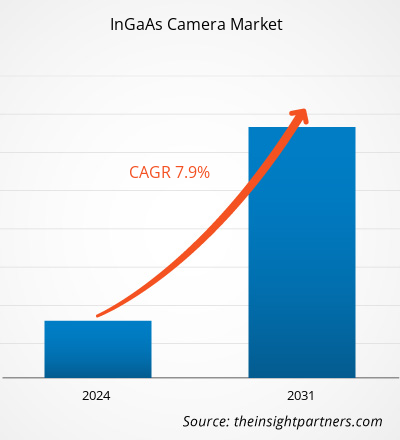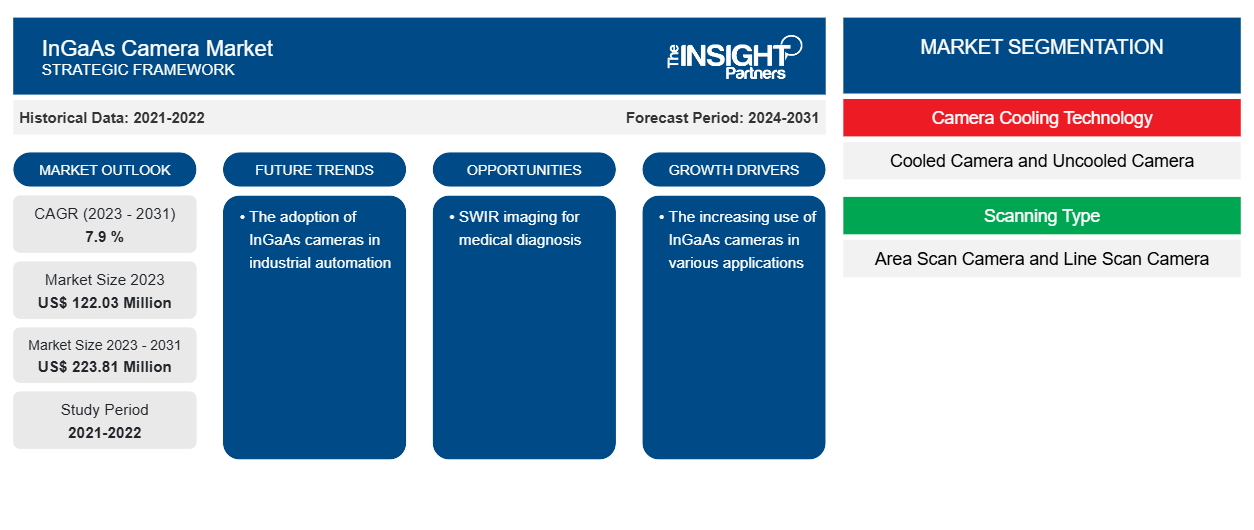Der Markt für InGaAs-Kameras soll von 122,03 Millionen US-Dollar im Jahr 2023 auf 223,81 Millionen US-Dollar im Jahr 2031 anwachsen. Der Markt soll zwischen 2023 und 2031 eine durchschnittliche jährliche Wachstumsrate (CAGR) von 7,9 % verzeichnen. Der Einsatz von InGaAs-Kameras in der industriellen Automatisierung dürfte ein wichtiger Trend auf dem Markt bleiben.
Marktanalyse für InGaAs-Kameras
Das Wachstum des InGaAs-Kameramarktes wird der zunehmenden Verwendung dieser Kameras in verschiedenen Anwendungen zugeschrieben, beispielsweise in der industriellen Automatisierung und der medizinischen Diagnostik . Eine SWIR-Kamera kann dies verhindern und so einen reibungslosen Produktionsprozess gewährleisten. Daher treibt die zunehmende Verwendung von InGaAs-Kameras in verschiedenen Anwendungen den InGaAs-Kameramarkt an. Auch SWIR-Bildgebungstechniken wie SWIR-Hyperspektralbildgebung für biomedizinische Anwendungen und ein breitbandiges (VIS+SWIR) digitales holografisches Mikroskopsystem basierend auf einem neuartigen Quantenpunkt-(QD)-Bildsensor werden diskutiert. Daher treibt die zunehmende Verwendung von InGaAs-Kameras in verschiedenen Anwendungen den Markt an.
Marktübersicht für InGaAs-Kameras
InGaAs-Sensoren werden in den physikalischen und Biowissenschaften eingesetzt und erfordern eine hohe Empfindlichkeit im Wellenlängenbereich von 900–1700 nm, der als kurzwelliges Infrarot (SWIR) bezeichnet wird. Einige InGaAs-Sensoren können aufgrund der Änderungen in der Materialzusammensetzung bis zu 2500 nm messen. Obwohl siliziumbasierte CCD-Kameras über eine Empfindlichkeit im UV- bis NIR-Bereich verfügen, verhindern die Bandlückeneigenschaften von Silizium, dass diese CCDs über 1100 nm hinaus ausreichend empfindlich sind. InGaAs-Kameras haben eine geringere Bandlücke, was dieses Material zum bevorzugten Material für Anwendungen im kurzwelligen Infrarotbereich (SWIR) macht.
Passen Sie diesen Bericht Ihren Anforderungen an
Sie erhalten kostenlos individuelle Anpassungen an jedem Bericht, einschließlich Teilen dieses Berichts oder einer Analyse auf Länderebene, eines Excel-Datenpakets sowie tolle Angebote und Rabatte für Start-ups und Universitäten.
-
Holen Sie sich die wichtigsten Markttrends aus diesem Bericht.Dieses KOSTENLOSE Beispiel umfasst eine Datenanalyse von Markttrends bis hin zu Schätzungen und Prognosen.
Treiber und Chancen auf dem InGaAs-Kameramarkt
Der zunehmende Einsatz von InGaAs-Kameras in verschiedenen Anwendungen
Die Inspektion von Siliziumkristallen und -blöcken (auch als Bricks bekannt) ist eine der beliebtesten Anwendungen für InGaAs-Kameras im Halbleitersektor. Die Fähigkeit, in einem Wellenlängenbereich über 1.150 nm in Silizium zu sehen, macht InGaAs-Kameras zu einer geeigneten Lösung für die Erkennung von Einschlüssen, wie z. B. Verunreinigungen in einem Kristall oder Block, die sich während des Produktionsprozesses ansammeln können. Die Verunreinigungen sind kritisch, wenn die Blöcke in dünne Wafer mit einer Diamantkette untersucht werden. Wenn die Kette auf ein Element trifft, wie z. B. ein kleines Stück Metall, kann die außergewöhnlich teure Kette reißen. Der Austausch einer Kette verursacht nicht nur Kosten, sondern führt auch zu geringerer Produktivität und reduzierten Gewinnen. Eine SWIR-Kamera kann dies verhindern und so einen reibungslosen Produktionsprozess gewährleisten. Daher treibt der zunehmende Einsatz von InGaAs-Kameras in verschiedenen Anwendungen den InGaAs-Kameramarkt an.
SWIR-Bildgebung für die medizinische Diagnose
SWIR-Bildgebung wird in der medizinischen Diagnostik eingesetzt. Die Entwicklung von Techniken auf Basis von SWIR-Licht, einschließlich der Herstellung und Verwendung von SWIR-Nanopartikeln als photothermische Wirkstoffe und lumineszierende Nanothermometer, sowie die jüngsten Fortschritte in der Struktur, dem Design und den SWIR-bezogenen biomedizinischen Anwendungen von mit Seltenen Erden dotierten Nanopartikeln (REDNs). REDNs gehören zu den leuchtstärksten und biokompatibelsten SWIR-Emittern. SWIR-Bildgebungstechniken wie SWIR-Hyperspektralbildgebung für biomedizinische Anwendungen und ein breitbandiges (VIS+SWIR) digitales holografisches Mikroskopsystem auf Basis eines neuartigen Quantenpunkt-(QD)-Bildsensors werden ebenfalls diskutiert. Somit treibt die zunehmende Verwendung von InGaAs-Kameras in verschiedenen Anwendungen den Markt an.
Segmentierungsanalyse des InGaAs-Kamera-Marktberichts
Wichtige Segmente, die zur Ableitung der InGaAs-Kameramarktanalyse beigetragen haben, sind Kamerakühltechnologie, Scantyp und Anwendung.
- Basierend auf der Kamerakühltechnologie ist der InGaAs-Kameramarkt in gekühlte und ungekühlte Kameras unterteilt. Das Softwaresegment hatte im Jahr 2023 einen größeren Marktanteil.
- Nach Scantyp ist der Markt in Flächenscankameras und Zeilenscankameras segmentiert.
- Nach Anwendung ist der Markt in Militär und Verteidigung, industrielle Automatisierung und wissenschaftliche Forschung segmentiert.
InGaAs-Kamera Marktanteilsanalyse nach Geografie
Der geografische Umfang des InGaAs-Kameramarktberichts ist hauptsächlich in fünf Regionen unterteilt: Nordamerika, Asien-Pazifik, Europa, Naher Osten und Afrika sowie Süd- und Mittelamerika.
APAC dominiert den Markt für InGaAs-Kameras. Die steigende Nachfrage nach Automatisierung in der Industrie, zerstörungsfreien Prüfungen und der zunehmende Einsatz von Bildverarbeitungsanwendungen dürften das Wachstum des Marktes für InGaAs-Kameras im Prognosezeitraum vorantreiben.
Regionale Einblicke in den InGaAs-Kameramarkt
Die regionalen Trends und Faktoren, die den InGaAs-Kameramarkt während des Prognosezeitraums beeinflussen, wurden von den Analysten von Insight Partners ausführlich erläutert. In diesem Abschnitt werden auch die Marktsegmente und die Geografie von InGaAs-Kameras in Nordamerika, Europa, im asiatisch-pazifischen Raum, im Nahen Osten und Afrika sowie in Süd- und Mittelamerika erörtert.

- Erhalten Sie regionalspezifische Daten zum InGaAs-Kameramarkt
Umfang des InGaAs-Kamera-Marktberichts
| Berichtsattribut | Details |
|---|---|
| Marktgröße im Jahr 2023 | 122,03 Millionen US-Dollar |
| Marktgröße bis 2031 | 223,81 Millionen US-Dollar |
| Globale CAGR (2023 - 2031) | 7,9 % |
| Historische Daten | 2021-2022 |
| Prognosezeitraum | 2024–2031 |
| Abgedeckte Segmente |
Mit Kamera-Kühltechnologie
|
| Abgedeckte Regionen und Länder |
Nordamerika
|
| Marktführer und wichtige Unternehmensprofile |
|
Marktteilnehmerdichte: Der Einfluss auf die Geschäftsdynamik
Der Markt für InGaAs-Kameras wächst rasant. Dies wird durch die steigende Nachfrage der Endnutzer aufgrund von Faktoren wie sich entwickelnden Verbraucherpräferenzen, technologischen Fortschritten und einem größeren Bewusstsein für die Vorteile des Produkts vorangetrieben. Mit der steigenden Nachfrage erweitern Unternehmen ihr Angebot, entwickeln Innovationen, um die Bedürfnisse der Verbraucher zu erfüllen, und nutzen neue Trends, was das Marktwachstum weiter ankurbelt.
Die Marktteilnehmerdichte bezieht sich auf die Verteilung von Firmen oder Unternehmen, die in einem bestimmten Markt oder einer bestimmten Branche tätig sind. Sie gibt an, wie viele Wettbewerber (Marktteilnehmer) in einem bestimmten Marktraum im Verhältnis zu seiner Größe oder seinem gesamten Marktwert präsent sind.
Die wichtigsten auf dem InGaAs-Kameramarkt tätigen Unternehmen sind:
- Hamamatsu Photonics KK
- Allied Vision Technologies GmbH
- Neue Bildgebungstechnologien
- Pembroke Instruments LLC
- Polytec GmbH
- Raptor Photonics Limited
Haftungsausschluss : Die oben aufgeführten Unternehmen sind nicht in einer bestimmten Reihenfolge aufgeführt.

- Überblick über die wichtigsten Akteure auf dem InGaAs-Kameramarkt
Neuigkeiten und aktuelle Entwicklungen zum InGaAs-Kameramarkt
Der Markt für InGaAs-Kameras wird durch die Erhebung qualitativer und quantitativer Daten aus Primär- und Sekundärforschung bewertet, die wichtige Unternehmensveröffentlichungen, Verbandsdaten und Datenbanken umfasst. Nachfolgend sind einige der Entwicklungen auf dem Markt für InGaAs-Kameras aufgeführt:
- Hamamatsu Photonics, ein führender Anbieter modernster Photoniktechnologie und -produkte, hat eine neue InGaAs-Kamera mit Empfindlichkeit im sichtbaren bis nahen Infrarotbereich von 400 nm bis 1700 nm vorgestellt. (Quelle: Hamamatsu Photonics, Pressemitteilung, Februar 2024.)
- BlueVision Ltd., Japan, hat im April 2021 eine neue 1K SWIR-Zeilenkamera namens BV-C3110 auf den Markt gebracht, einen brandneuen 1K InGaAs-Sensor (Quelle: BlueVision Ltd, Pressemitteilung, April 2021)
Marktbericht zu InGaAs-Kameras – Abdeckung und Ergebnisse
Der Bericht „Marktgröße und Prognose für InGaAs-Kameras (2021–2031)“ bietet eine detaillierte Analyse des Marktes, die die folgenden Bereiche abdeckt:
- InGaAs-Kamera-Marktgröße und -prognose auf globaler, regionaler und Länderebene für alle wichtigen Marktsegmente, die im Rahmen des Berichts abgedeckt sind
- Markttrends für InGaAs-Kameras sowie Marktdynamiken wie Treiber, Einschränkungen und wichtige Chancen
- Detaillierte PEST/Porters Five Forces- und SWOT-Analyse
- Marktanalyse für InGaAs-Kameras mit wichtigen Markttrends, globalen und regionalen Rahmenbedingungen, wichtigen Akteuren, Vorschriften und aktuellen Marktentwicklungen
- Branchenlandschaft und Wettbewerbsanalyse, einschließlich Marktkonzentration, Heatmap-Analyse, prominenten Akteuren und aktuellen Entwicklungen für den InGaAs-Kameramarkt
- Detaillierte Firmenprofile
- Historische Analyse (2 Jahre), Basisjahr, Prognose (7 Jahre) mit CAGR
- PEST- und SWOT-Analyse
- Marktgröße Wert/Volumen – Global, Regional, Land
- Branchen- und Wettbewerbslandschaft
- Excel-Datensatz
Aktuelle Berichte
Verwandte Berichte
Erfahrungsberichte
Grund zum Kauf
- Fundierte Entscheidungsfindung
- Marktdynamik verstehen
- Wettbewerbsanalyse
- Kundeneinblicke
- Marktprognosen
- Risikominimierung
- Strategische Planung
- Investitionsbegründung
- Identifizierung neuer Märkte
- Verbesserung von Marketingstrategien
- Steigerung der Betriebseffizienz
- Anpassung an regulatorische Trends























 Kostenlose Probe anfordern für - InGaAs-Kameramarkt
Kostenlose Probe anfordern für - InGaAs-Kameramarkt